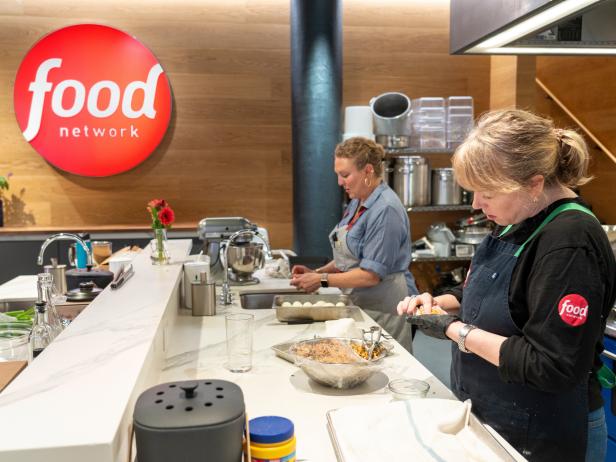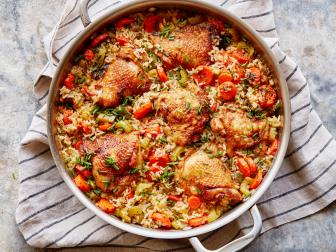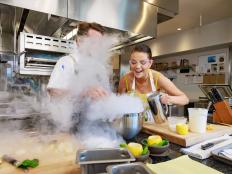
Mark Peterson/Redux Pictures
The Food Network Kitchen in our Manhattan office is where we test recipes for the website and shows, film social videos, and more. The kitchen can accommodate more than a dozen chefs at one time. Here, executive chef Ginevra Iverson (left) and recipe developer Martha Tinkler prep for an event.
What is Food Network Kitchen?
We often joke that Food Network Kitchen is a “person, place, thing and idea.” Of course, it is a place — the kitchen studio space which resides in our office in New York City. But Food Network Kitchen wouldn't be anything without the people who comprise it. The Food Network Kitchen team develops recipes, tests products, preps for Food Network shows, produces videos and social content, hosts events and much more. And "Food Network Kitchen" is the marker of this team's inspiring, helpful and trustworthy content on FoodNetwork.com.
Every recipe or article you see on FoodNetwork.com that is "from Food Network Kitchen" is created by our team of editors and recipe developers. We work with all sorts of culinary experts, from bakers to restaurant chefs to recipe developers who've spent their careers in magazines and digital media. Plus, we work with experts in cuisines from all over the United States and the world.
We're experts, but we know you, and we don't try to be chef-y or unapproachable or difficult. Our number one goal is to create recipes that you'll love to make again and again and that solve the cooking problems you have every day. You want to get dinner on the table faster and more easily, you want to learn the tricks to making a recipe you've never made before, and you don't want to waste money on ingredients for a recipe that doesn't come out great. You want recipes that you can trust will work in your kitchen — and so do we.
Behind the Scenes
Food Network Magazine visited Food Network Kitchen to capture some behind-the-scenes snaps and fill you in on all the goodness.
Take a Tour of the Food Network Kitchen 13 Photos
Peek inside Food Network's test kitchen and production spaces in New York City, where we develop recipes, prep food for your favorite shows, and more.
Meet Our Recipe Development Team
Ginevra Iverson
Executive ChefGinevra Iverson is the Executive Chef of Food Network and has been working here since 2015. She started as a Recipe Developer with Food Network Magazine and now runs the day-to-day operations of Food Network Kitchen.
Steve Jackson
Test Kitchen DirectorSteve is a full-time recipe developer at Food Network and became the Test Kitchen Manager of Food Network Magazine in 2016, and has been Test Kitchen Director since 2017.
Andy Liang
Recipe DeveloperAndy Liang is a Recipe Developer at Food Network, where he does in-depth research and multiple rounds of testing to make recipes come to life. Andy attended the International Culinary Center and focuses on bringing Cantonese recipes to life.
Amanda Neal
Lead Recipe DeveloperAmanda is the Lead Recipe Developer at Food Network, where she creates original recipe content for Food Network’s digital and linear platforms. She's a trained chef who’s been working in the food industry for over 10 years at various media outlets and restaurants.
Meet Our Editors
Lauren Piro
Digital Director, EditorialLauren has been the Digital Director of Editorial at Food Network for six years. She leads editorial content strategy and execution across Food Network's digital platforms and is heavily involved in the brand's digital content marketing and brand partnerships.
Heath Goldman
Culinary EditorHeath has been a culinary editor at Food Network for over five years, where she writes instructional cooking articles and creates recipes that are low maintenance with big flavor. She's a trained chef who’s been creating food content for national publications for over ten years.
Margaret Wong
Writer and EditorMaggie has been an editor and writer for Food Network for over four years, with a focus on food culture, news, trends and healthy eating. Previously, she worked on the editorial team for Food Network’s Snapchat Discover channel for four years.
Alessandra Bulow
Senior EditorAlessandra is Food Network’s Senior Editor and oversees the thousands of recipes from the Food Network shows, digital series and TikTok videos you love the most. She has been editing, writing and producing digital and print media for over a decade.
How Do We Test Recipes?
Our editors and recipe developers are always discussing what new recipes we'd like on FoodNetwork.com. We talk about trends we've seen, recipes we know you're searching for and want more of, fun weeknight and holiday solutions, cuisines we want to highlight, new techniques we want to try and more. We develop dozens of new recipes every month to share in our Recipe of the Day newsletter and on Food Network's social channels — make sure you're following us so you can find our new stuff! (Insider scoop: Our brainstorm document is actually called "the list of incredible ideas," as we think they are, well, pretty incredible.)
Then our recipe developers get cooking. We research similar recipes (there's a cookbook library in our office with over 4,000 titles!), watch social videos to see what's new and cool, consider flavor combos and potential techniques. We write up a first draft of how we think the recipe will work best, but the proof is in the pudding (we like food puns). We cook it and decide how we feel about the flavor and texture, but also the ease of the recipe and if the juice is worth the squeeze (sorry, told ya!). If we're not happy with the first pass, we try again — and often try multiple techniques (to layer or not layer a biscuit?) or ingredients (do we want nuts, chocolate or both?) to compare in the early rounds of testing.
We feel like we've nailed it when a recipe is streamlined without cutting the important corners, and of course tastes great. One of the major perks of this job is taste-testing so many recipes!
But we're not done yet. Once the recipe developer and our editorial team are satisfied with the recipe's outcome, we send it to cross-test. Another one of our kitchen teammates will remake the recipe, following the directions as written, and make notes on any adjustments they think the recipe should have. Is the cooking time too short or long? Are the directions unclear? Did we forget an ingredient? We want these recipes to work well in your home kitchen, and this step helps ensure that.
How Do We Edit Recipes?
After a recipe makes it through cross-testing, another person gives it a once-over with fresh eyes: the recipe editor. We review the copy to make sure the directions are perfectly clear and include all the important details like the equipment you need, heat level, visual cues and cooking time. Our recipe editors ask the recipe developer to clarify any ingredients or directions that might be confusing, offer the reason behind techniques and smooth the text to make it as concise and easy to follow as possible.
Each recipe headnote (that paragraph of text at the top of the recipe) highlights our advice, tips and point-of-view, and is edited and fact-checked. We also have a registered dietitian review any recipes that are labeled healthy, gluten-free, vegan, high-protein or other special diets (read about our healthy guidelines here).
In addition to the Food Network Kitchen recipes, we edit all of the Food Network stars' recipes you see on FoodNetwork.com for clarity and style.
Tips for Cooking from Food Network Kitchen Recipes
We like Diamond Crystal Kosher salt.
Salt comes in all shapes sizes, and flavors, but ask a chef what they prefer, and they will probably say "Diamond Crystal" — and we think it works amazingly well at home too. It's the perfect shape and density for pinching and seasoning with ease, and has a manageable level of salinity that makes it hard to over-season.
When you're making a Food Network Kitchen recipe, if you use the other popular Kosher salt — Morton's — you may find that your recipe comes out a little salty. Morton's is denser and saltier than Diamond Crystal, and regular table salt is even saltier; never try to swap kosher salt for table salt.
If we want you to use another type of salt, like fine salt for baking, we'll make it clear in the recipe ingredient list.
We include "active time" and "total time" in each recipe, so it’s easier to plan ahead — but we also encourage you to adjust and taste as you go.
The "active time" is how much time you'll spend physically preparing the dish. Think preparing and working (slicing, peeling, dicing, rolling) and actively cooking (sautéing, deep-frying, grilling). If you can walk away for an extended period — like when you put a cake in the oven — it is not active time.
The "total time" is the amount it takes to complete the entire recipe from start to finish. If the time includes significant periods of marinating, chilling, resting or rising, we include this in parentheses.
Of course, every kitchen and every cook are different, so while our recipes include these times, doneness cues and other instructions as helpful guides, you might your equipment cooks things a bit faster or slower, or that your tastebuds prefer some adjustments. That's OK! Part of the joy of cooking is figuring out your preferences and what works well for you.
We like to minimize food waste.
Grocery shopping is half the work of cooking and, as much as we can, we call for whole ingredients that are shopping list-friendly and prevent waste. For instance, when we call for an apple or a can of chickpeas, the entire amount will be used, since any less leaves you with an awkward amount that doesn't always store easily. Plus, to help you make sure you don’t forget to add an ingredient when cooking, we list the ingredients in the order you use them in the directions.
We test our recipes on the equipment that you're using at home, so you can be sure it will work.
Got an air fryer, rice cooker or Instant Pot? So do we (and much more) and every time there's a trendy new kitchen appliance on the market, we want to make sure you have the best recipes for cooking with it. And not only do we test recipes on these items, but we also test lots of brands of the products themselves so we can tell you which ones are best.
Read the recipe's headnotes (at the top) and Cook's Notes (at the bottom) for more perspective and advice.
Here's where we leave the answers to the questions you might have about a specific cooking technique or ingredient, our ideas for serving suggestions and substitutions, and anything else we might want you to know about a recipe. We encourage you to read the recipe and gather your ingredients (mise en place!) before you start cooking.
Our healthy recipes meet very specific guidelines, and are vetted by registered dietitians.
We don't like to throw the word "healthy" onto just anything. While there are certainly different definitions of the term, ours thoughtfully considers what the science says about nutritional balance, and we work with registered dietitians on any recipe, article or video that touches on health advice. Read more about our healthy recipes here.
Leave us a review after you make a recipe!
We love hearing how our recipes turned out in your kitchen (it makes us better cooks and gives us new ideas!), and your notes help other readers make the recipes too.
Our Official List of the Best Food Network Kitchen Recipes 107 Photos
We tinkered. We tested. We tested again. We tweaked these recipes until they were absolutely perfect—tried-and-true dishes that are sure to stand the test of time. We feel 100% confident in calling them our "Bests." Try them, and we bet you'll agree.
Who Else Works in Food Network Kitchen?
Our teams of culinary producers, stylists and operations staff bring Food Network's shows to life on TV and work on the original content that you see right here on FoodNetwork.com and our Facebook, Instagram, YouTube and TikTok. They're Food Network's expert culinary eyes, ears and hands on set, prepping food and supporting contestants and talent with their expertise. Some days they're running ingredients on a competition show, or prepping recipes to shoot with the stars visiting Food Network Kitchen; other days they're making 1,000 gallons of tomato sauce for a lasagna-building charity event. There is never a dull moment in Food Network Kitchen, and if it requires a knife and pan, we know just how to get it done.
Food Network Kitchen Staff
Dave Mechlowicz
Head of Culinary Production and OperationsMorgan Hass
Lead Director of Culinary ProductionSuzanne Keating
Director, Culinary Production Management & OperationsJennifer Bierman
Director of Culinary ProductionMelissa Forte
Culinary Operations ManagerNikki Scott
Supervising Culinary ProducerLiza Zeneski
Supervising Culinary ProducerAthen Fleming
Head StewardMatthew Skrincosky
Food StylistRicky Scott
StewardAnd Don't Forget Our Shopping Experts!
Food Network's culinary team and editors are committed to testing as many kitchen products as we can — so we can tell you all about the best ones. Read more about our shopping experts and why you should trust our recommendations.




























































































































































